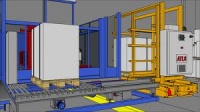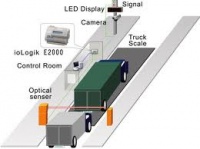Difference between revisions of "Truck Loading Systems"
(Created page with "Category: Loading and Unloading Equipment{{Knoppen}} <noinclude><!------------------------------------------------ * READ THIS FIRST * Only edit this page if you can imp...") |
PurplePen19 (talk | contribs) |
||
| Line 7: | Line 7: | ||
* Please start editing this page after the /noinclude | * Please start editing this page after the /noinclude | ||
* -------------------------------------------------></noinclude> | * -------------------------------------------------></noinclude> | ||
[[File:Truck Loading Systems_1.jpg|thumb|200px|right|Truck Loading Systems]] | |||
[[File:Truck Loading Systems_2.jpg|thumb|200px|right|Truck Loading Systems Diagram]] | |||
'''Truck Loading Systems''' are systems that are used commonly in constructions. Commonly automatic, ATLS has been commonly used in the material handling industry to refer to the automation of loading or unloading trucks and trailers with product either on or without pallets, slip sheets, racks, containers, using several different types of automated guided vehicle systems (AGV) or engineered conveyor belt systems that are integrated into vehicles, automating the shipping / receiving and logistics operations. Automatic truck loading and unloading always requires two ‘combined’ systems: one system in the trailer and a ‘fixed’ installation inside the loading and unloading dock. When a trailer docks the entire load is loaded or unloaded automatically. | |||
==Benefits== | |||
The most commonly used truck loading and unloading systems are for shuttle services between production facilities and distribution centres. Truck loading and unloading times are reduced from half an hour to a matter of minutes. Return on investment times are short due to the immediate savings compared to traditional loading and unloading (using fork-lift or hand pallets trucks). | |||
*Fewer logistics personnel due to automation of the loading and unloading process; | |||
*Fewer fork-lift trucks and associated equipment due to mechanisation of the loading and unloading process; | |||
*Fewer loading and unloading docks because each dock can handle higher volumes; | |||
*Fewer trucks, trailers and drivers due to increased fleet utilisation; | |||
*Less warehouse space due to more concentrated flow of goods; | |||
*Less buffer stock due to quicker inbound and outbound transportation of goods; | |||
*Less space outside due to quicker turnaround times of trailers; | |||
*Reduced damage of goods and equipment due to a controlled loading and unloading process; | |||
*Safer working environment for personnel. | |||
==Videos== | |||
<youtube>ga2t-a_VGhY</youtube> | |||
Latest revision as of 07:38, 4 September 2013
Truck Loading Systems are systems that are used commonly in constructions. Commonly automatic, ATLS has been commonly used in the material handling industry to refer to the automation of loading or unloading trucks and trailers with product either on or without pallets, slip sheets, racks, containers, using several different types of automated guided vehicle systems (AGV) or engineered conveyor belt systems that are integrated into vehicles, automating the shipping / receiving and logistics operations. Automatic truck loading and unloading always requires two ‘combined’ systems: one system in the trailer and a ‘fixed’ installation inside the loading and unloading dock. When a trailer docks the entire load is loaded or unloaded automatically.
Benefits
The most commonly used truck loading and unloading systems are for shuttle services between production facilities and distribution centres. Truck loading and unloading times are reduced from half an hour to a matter of minutes. Return on investment times are short due to the immediate savings compared to traditional loading and unloading (using fork-lift or hand pallets trucks).
- Fewer logistics personnel due to automation of the loading and unloading process;
- Fewer fork-lift trucks and associated equipment due to mechanisation of the loading and unloading process;
- Fewer loading and unloading docks because each dock can handle higher volumes;
- Fewer trucks, trailers and drivers due to increased fleet utilisation;
- Less warehouse space due to more concentrated flow of goods;
- Less buffer stock due to quicker inbound and outbound transportation of goods;
- Less space outside due to quicker turnaround times of trailers;
- Reduced damage of goods and equipment due to a controlled loading and unloading process;
- Safer working environment for personnel.
Videos

